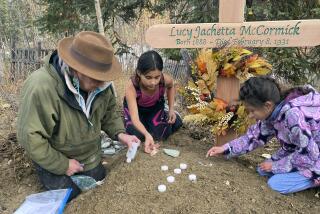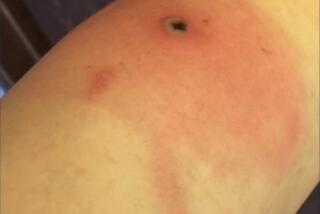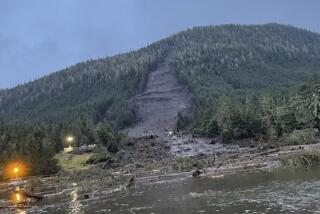Probable Site of Alaskan Massacre Explored : History: Archeologists seek better understanding of what happened when Russians battled villagers in 1784.
SITKALIDAK ISLAND, Alaska — In 208 years, a lot of history can be forgotten--the Russian cannon fire, the cries of women and children hurling themselves 100 feet into the sea, the defeat of a proud people.
All of these things happened at a small, raised buttress known as Refuge Rock near the village of Old Harbor. A Russian force, led by fur traders, conquered the Alutiiq of Kodiak Island, leaving hundreds dead.
How many? No one knows. What happened? Accounts differ.
The site of the massacre was lost for two centuries. But now, there is reason to hope that more will be known about this bloody moment in native Alaskan history.
Archeologist Rick Knecht said he discovered the spot two years ago while flying overhead on other business. In July, 10 volunteer archeologists--prompted by native villagers who wanted to know more about their past--began excavation of the site.
“We hope to find some more clues about what happened that afternoon in 1784,” said Knecht.
Why delve into this sad chapter?
“The beginning of forgiveness is understanding, and the beginning of understanding is knowledge,” Knecht said during a recent trip to the site.
The battle “broke the back” of native Alaskan resistance, Knecht said. “It was the Wounded Knee of Alaska.”
In the mid-1700s, Russian fur traders and their hired seamen fought for a foothold in the Aleutian Islands and Kodiak Archipelago. As expeditions moved east, the explorers battled Aleut and Alutiiq warriors intent on repulsing the Russians’ landings.
In 1784, trader Grigori Shelikhov moved to end the impasse and impose the Russians’ will by force.
After stopping at Three Saints Bay on southeastern Kodiak Island, Shelikhov sent several boats with 2.5-pound cannons and 130 armed men to Refuge Rock.
Villagers traditionally had gathered at the refuge while under threat of attack during the frequent battles between native groups from Kodiak and the Aleutians. They felt safe atop the fortress-like rock connected by a spit at low tide to nearby Sitkalidak Island.
Historical and native oral accounts of what happened that August afternoon vary in detail and tone, although the outcome is largely undisputed: Shelikhov and his men sailed their boats into a hidden inlet behind the rock, a secret route shown to them by an Aleut translator and guide known as Kashpak.
After several days of negotiations and a brief skirmish between the groups, the Russians attacked, using cannons and muskets against spears and arrows.
The village and fortress were destroyed.
Historians note that Shelikhov and his men had prepared for battle before leaving Okhotsk in the Russian Far East. That was unusual. Few Russian merchant ships of that day were armed; Shelikhov had received special permission to equip his party with cannons and muskets.
Shelikhov--as was the common practice--demanded that the natives turn over hostages and trade with him for the highly valuable otter furs then in great demand with buyers in China. The natives refused.
The czar prohibited merchants and traders from using violence against North America’s native people, except in extreme cases and only in self-defense. So Shelikhov’s description of the day’s events were favorable to him.
He insisted in his reports that he had been badly outnumbered, was attacked first and feared a growing concentration of native warrior reinforcements.
Others painted a darker picture.
Ship physician and eyewitness Miron Britiukov, in a scathing account to the czar, cited numerous atrocities and denounced Shelikhov’s action.
Eyewitness reports indicate that there were about 2,000 villagers at the refuge. Britiukov estimated that 500 were killed and more drowned, including women, children and elders, when they threw themselves off the 10-story seaside cliffs to escape the onslaught. Others were taken prisoner; some were executed.
Other accounts put the death toll at 200 to 300 villagers.
Lydia T. Black, a Russian-born anthropologist at the University of Alaska Fairbanks, said her studies indicate that neither extreme view is entirely accurate.
Shelikhov overstated the fierceness of the natives, their number and the threat they posed to his party, she said; Britiukov understated them.
There had been a stiff Aleut and Alutiiq resistance for years: Warriors had destroyed four ships and their crews in the years before the landing at Sitkalidak Island, and Shelikhov came looking for a fight, Black said. She describes the attack as a watershed event in the settlement of what became Russian America, and later Alaska.
“This was the beginning of the end for the Alutiiq of Kodiak Island,” she said. “Shelikhov really smashed their military might. It was their first major military defeat.”
Natives of the Old Harbor and southern Kodiak Island have long heard stories--part of the region’s aboriginal oral history--of hundreds dying at Refuge Rock, of bodies lining the shores. But there had been no physical proof.
Knecht said the place that is being excavated fits perfectly the historical description of the site provided by witnesses, and that he is “95% sure” it is the massacre site described in Shelikhov’s writings and other accounts. Knecht hopes the metal detectors and painstaking excavation of house pits will turn up evidence such as Russian cannon or musket balls.
Native leaders want to have the site entered on the National Registry of Historic Places. Later this summer, a Russian Orthodox priest from Old Harbor will conduct a memorial service there, and a Russian Orthodox cross will be erected on Refuge Rock.
More to Read
Sign up for Essential California
The most important California stories and recommendations in your inbox every morning.
You may occasionally receive promotional content from the Los Angeles Times.










